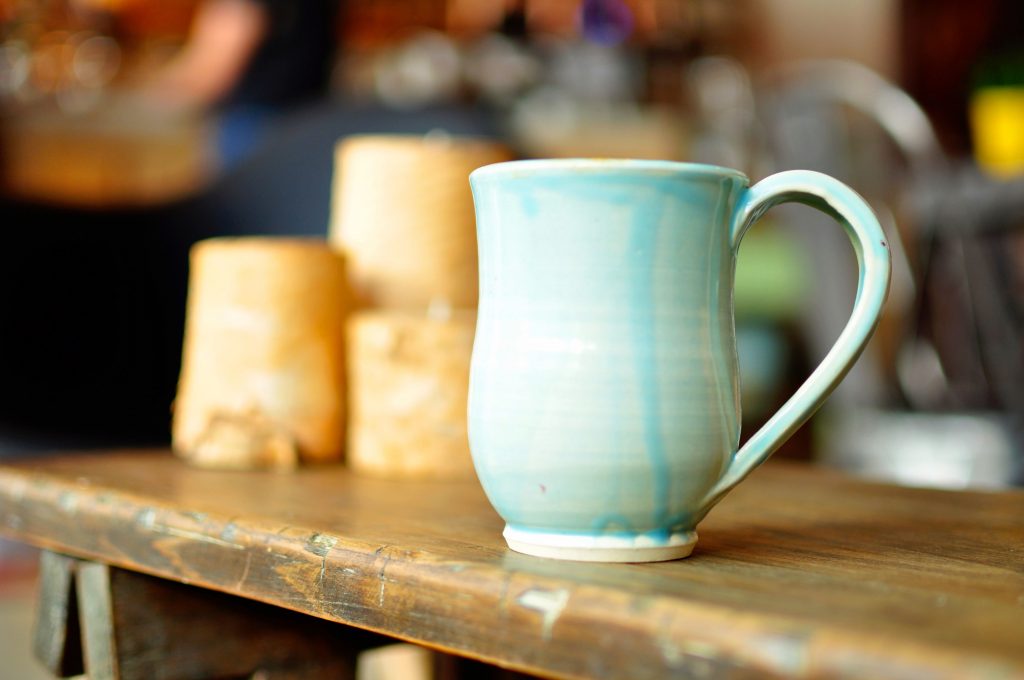Pottery painting is a fun hobby that always creates beautiful art. If you’re new to the world of pottery and you’re hesitant to try it, this article will definitely change your mind.
There are a lot of ways you can paint your clay or ceramic. You can go simple or create a Picasso out of your pottery. There are also many media that you can experiment with.
In this article, I’ll show you my top 10 pottery painting ideas, and the paints that work best with them!
What You Should Know about Pottery Painting
Painting a mug is the easiest if you know exactly what you’re getting into. Just like any new skill that you plan on learning, you must know your tools before you try experimenting with clay.
First of all, pottery comes in two forms: greenware and bisqueware. Greenware is any clay piece that hasn’t been fired yet. It can be bone-dry or leather dry.
On the other hand, when the clay is fired under high temperature, it’s called bisqueware or bisque fired.
Second, clay is best painted before completely drying. Or in case of being leather dry. During this state, clay can be easily painted and decorations can be carved without any hassle.
Once the clay is bisque fired, it now becomes ceramic. You can paint ceramic but you can no longer adjust it or carve anything on your pottery.

4 Types of Pottery Paints that You Must Know
You may have already seen some videos of people trying to teach their audience how to paint on clay or on ceramic.
It looks cool and fun but there are a lot of big words that you don’t understand such as glazing and underglazing.
You’re not alone, we were all confused and lost just like you are now. That’s why, before I introduce our top 10 pottery painting ideas, I’ll try to explain the four most important types of paints that you should know.
Underglazing
Underglazing refers to any painting that goes before a coat of transparent glaze seals the pottery. You know, that shiny smooth touch that pottery has, that is the glaze. It is the final coat that must cover the ceramic.
Underglazes are basically clay and water with some color added to the mix. They can be used for painting on greenware or bisque ware.
The most satisfying feature with these paints is, that once fired they don’t change. You get exactly the same result you wanted with your paints. Because you can control underglazes, you can use them for more detailed work.
Glazing
It’s a coat that covers ceramic pottery. It can be transparent, or it can have colors included. The transparent glaze is usually used for sealing the colors onto the piece. The colored glaze is used for painting.
Glazes include water, glass, flux, silica, and sometimes color. Each component has a function. For example, under heat, flux works on liquefying the glass while the silica helps melt it in order to cover the pottery.
Using glazes as paints won’t give you detailed work. Because once fired, the colors will melt creating unexpected shapes. Some colors will even be overwhelmed by stronger ones.
I can say that glazing is a battle where colors will melt, pop, and fight for dominance.
Since the results are unexpected, I advise you to experiment on a small piece of ceramic before going full creative-mode on your art piece.
Ceramic Paints
They’re toxin-free, very expensive, and more durable. I don’t advise to spend your money on these expensive paints if you’re a beginner. If you know what you’re doing, then go ahead. Ceramic paints the best in the market.
Acrylic Paints
This medium is used only for decorative pottery because it’s not safe for food. They’re available everywhere, but they’re not a very strong choice. They may wash away with water.
They also don’t give off a good effect since they can only be applied after glazing. So the color won’t be fully integrated with the clay which gives off a flat feeling.
If this is your first time with pottery, then painting with acrylics is the way to go. They’re very easy to apply, and you’ll be happy with your creations.
Top 10 Easy Painting Ideas You Should Try
Are you impressed by the beautiful pottery creations that you see on the internet? You can do just like them right now. Just grab the materials discussed above and you’re ready to start making art.
Don’t be scared to mess up, I picked these techniques because they are so easy. I believe that you can achieve great results if you try them.
Color Dripping
This technique is best achieved with bisque-fired pottery. You can dip your mug into a coat of paint, let it dry then do the same process until you’re satisfied with the color combination. The effect won’t be clear until it’s coned. So be patient.
After firing, the paint will melt creating an abstract-like painting. Then you’ll have the perfect pottery piece. You’ll be very proud.

Bubbles
Mix some water, paint and any dishwashing product. Blow into them to create bubbles, then put your mug closely to touch only the bubbles. By doing this, you’re creating a beautiful abstract effect. You’ll get what I mean once it’s fired.
Draw the Family
A fun activity for the whole family to try. Pick up a decorative tray. sketch a drawing of your family on top of it, then paint the picture.
The drawing doesn’t have to be fancy. Only some colored stick figures will do. Once they’re done, you will be surprised by the result.
Lace
There’s nothing more beautiful than lace. Once you pick your favorite pattern, place it on your pottery piece then just run your brush over it. You can choose any color you like.
Once it’s bisque fired, your pottery will turn into a perfect, detailed, and artistic piece.
Lettering or Graffiti
As the name suggests, you can just go simple by writing your initials. You can even write your favorite quote. Once done, place it on your wall and you’ll have a piece of art that will motivate you whenever you look at it.
You can create multiple pieces, then decorate a wall with them. This can become your motivational area of the house.
Mandala or Dots
This is so easy. Just paint on your mug random dots. When I say random I don’t mean a mess. Dots are simple but they can be tricky.
To avoid that, you can create a design on a white paper first, copy it with a pencil on your mug, then paint it. You don’t need to worry, pencil marks disappear once the clay is fired.
Masking Tape
This list won’t be complete without some tape thrown in the middle. You can cover any area you don’t want to be painted, then play with the shapes that the masking tape will create.
Use one color, or choose a color theme that you like, then go for it. I promise you, the result will look so professional and clean.
Negative Painting
Just pick any random shape you want. It could be a feather, a star, or some leaves. Place them on your pottery piece, then paint over them. Once the paint is dry, the shape will leave a non-painted space that looks like something you drew with your hands.
This technique is very simple. But think of the number of shapes that you can create using all kinds of objects. Simple but very rewarding.
Emojis
Who doesn’t love an emoji? They’re literally everywhere. They’re pillows, clothes, slippers, keychains, and now they’re turned into pottery pieces as well.
Everyone knows how to draw an emoji! They’re easy and fun. You can grab your mug and some paints, then start drawing faces of your favorite emojis. How hard can that be!
So if you want your coffee to speak to you, create emoji mugs. They can smile, wink, or even send you hearts.
Patterns and Shapes
Go ahead and paint rectangles, circles, hearts, flowers, or anything. There are countless numbers of patterns that you can copy basically from anywhere.
Just try them first on a piece of paper, then copy your favorite design on your clay. Be brave and just experiment.

Conclusion
With those top 10 pottery painting ideas, I guess you no longer have an excuse not to start painting pottery. As you can see, it’s simple. You just need some tools, some paints, and some determination.
Whatever paints you decide to try, remember to read the instructions very carefully. Every type of paint works with a specific type of clay. Besides, not all clay can be fired to the same heat, and not all paint will react to the same temperature.
You should start small and easy, just don’t be scared. Begin experimenting with smaller projects, then move on to bigger pieces of pottery. Only when you get over your fear that your possibilities will be endless.

